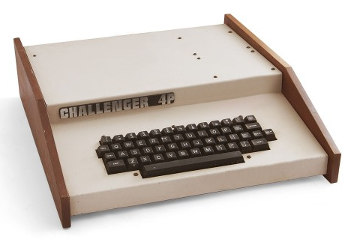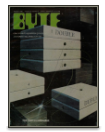Based on threaded code and similar to Forth, this language and interpreter/compiler aimed to be simple, easy to implement in ROM, and fit into only 2K, or 8K or both, depending on which version I was working on at the time.
This is a language and interpreter/compiler based on threaded code and resembling Forth, which I invented mostly during 1982-1983 to run on an Ohio Scientific Challenger IIp, a 6502-based microcomputer from 1979. More detail about the history of the language and projects attempting to implement it.
This machine had no persistent storage but a cassette tape unit, a simple extended ASCII video display of 25 lines of 40 characters (iirc), and some homebrew circuit mods to allow the MSB of ASCII codes to show a character as black on white instead of white on black, and produce audio.

My main interests in developing a language were: controlling hardware, audio and sensor signal processing in fixed point, and seeing what I could cram into an 8K ROM. I was also quite interested in the inner workings of compilers and interpreters.
These are elaborated upon in the more detailed pages, but a quick overview may be helpful:
The languages worked on the idea of "threaded code". This has nothing to do with multiple parallel sequences of execution, common since the 1990s, but is a notion of writing machine code used for implementing Forth. In my NCS, two types of executable code exist
More details are in the other pages, especially MonoByte Code page.
In those days, the prefix '$' indicated a hexadecimal number. The 'C' language and its notation for hex wasn't well known yet. I certainly hadn't heard of it. In most places in these HTML-transcribed notes, I've changed hex numbers to C-style, 0x076D, since that's what everyone has been using in all languages since the 1990s.
Monobyte code, "MBC", is a series of one-byte instructions, each invoking some keyword of the NCS language. A sequence of MBC would be interpreted by a small fast routine in 6502. Such a sequenced ended with a special return opcode, causing execution to return to the caller, which could be 6502 or MBC.
Every keyword of NCS could be defined in either 6502 or MBC. A definition could start with 6502 but convert to MBC.

The Evolution of FORTH, an Unusual Language, by Charles H Moore, BYTE August 1980 p 76+. History of how FORTH came about, from its inventor.
What is FORTH? A Tutorial Introduction, John S James, p100+. Explains the language and its inner workings.
BREAKFORTH Into FORTH! A. Richard Miller and Jill Miller, p 150. Details a real-time video game written in Forth for the TRS-80.
FORTH Extensibility - Or How to Write a Compiler in 25 Words or Less, Kim Harris, p. 164. THe juiciest article with inner workings of compiling, managing the dictionary, and executing.
FORTH GLossary, with the most common Forth words, gathered by Byte editor Gregg Williams, page 186.
Threaded Interpretive Languages, R. G. Loeliger, BYTE/McGraw-Hill, 1980
There is a conclusion at the end of the page for the Magellan Project. Galaxy didn't get as close to having a near-final body of source code; there is no specific conclusion to draw from that work. Overall, these points may be noted: